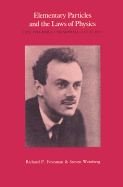The reason for antiparticles
Published online by Cambridge University Press: 18 December 2014
Summary
The title of this lecture is somewhat incomplete because I really want to talk about two subjects: first, why there are antiparticles, and, second, the connection between spin and statistics. When I was a young man, Dirac was my hero. He made a breakthrough, a new method of doing physics. He had the courage to simply guess at the form of an equation, the equation we now call the Dirac equation, and to try to interpret it afterwards. Maxwell in his day got his equations, but only in an enormous mass of ‘gear wheels’ and so forth.
I feel very honored to be here. I had to accept the invitation, after all he was my hero all the time, and it is kind of wonderful to find myself giving a lecture in his honor.
Dirac with his relativistic equation for the electron was the first to, as he put it, wed quantum mechanics and relativity together. At first he thought that the spin, or the intrinsic angular momentum that the equation demanded, was the key, and that spin was the fundamental consequence of relativistic quantum mechanics. However, the puzzle of negative energies that the equation presented, when it was solved, eventually showed that the crucial idea necessary to wed quantum mechanics and relativity together was the existence of antiparticles. Once you have that idea, you can do it for any spin, as Pauli and Weisskopf proved, and therefore I want to start the other way about, and try to explain why there must be antiparticles if you try to put quantum mechanics with relativity.
Working along these lines will permit us to explain another of the grand mysteries of the world, namely the Pauli exclusion principle. The Pauli exclusion principle says that if you take the wave-function for a pair of spin ½ particles and then interchange the two particles, then to get the new wave-function from the old you must put in a minus sign.
- Type
- Chapter
- Information
- Elementary Particles and the Laws of PhysicsThe 1986 Dirac Memorial Lectures, pp. 1 - 60Publisher: Cambridge University PressPrint publication year: 1987
- 8
- Cited by



